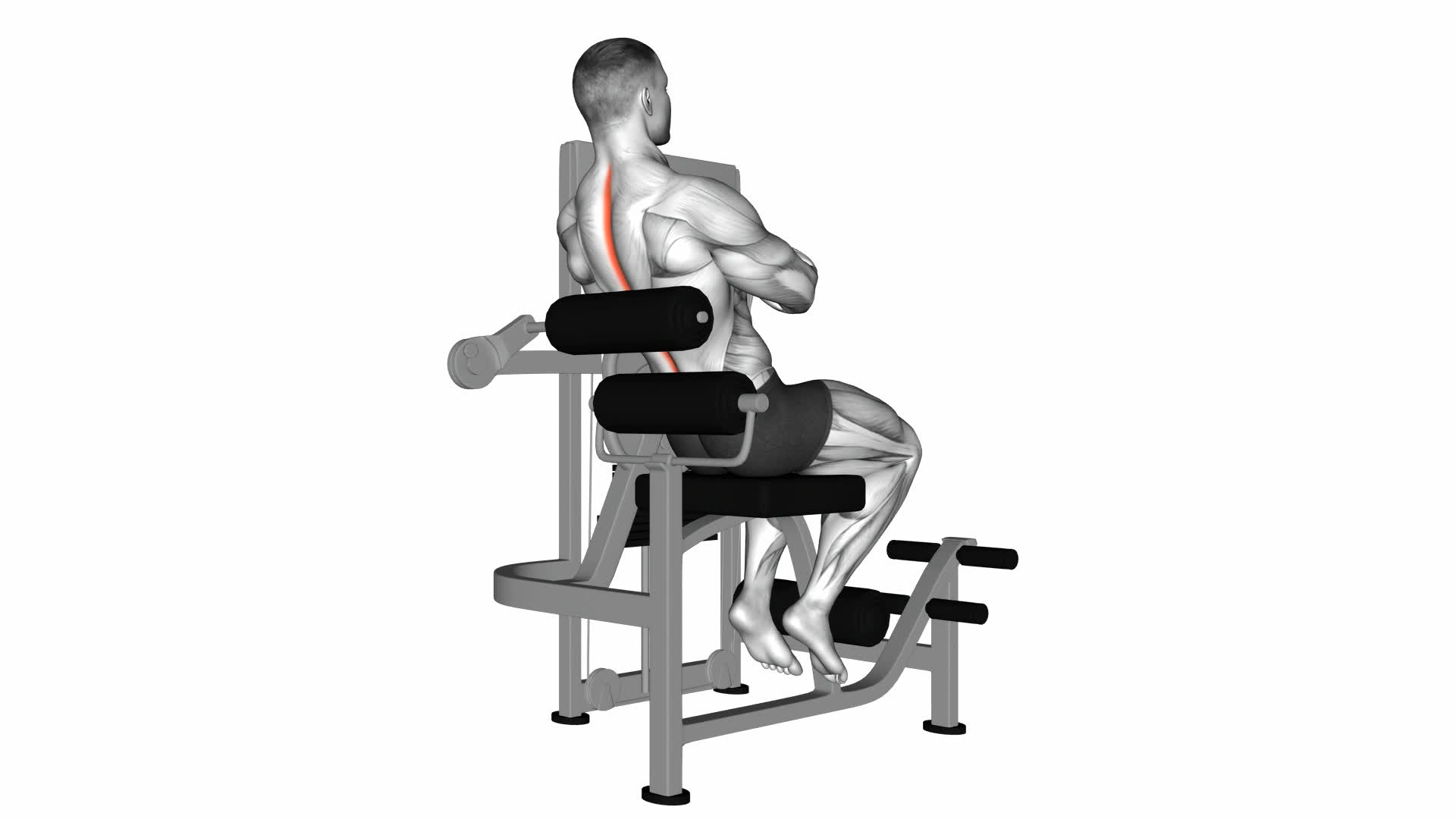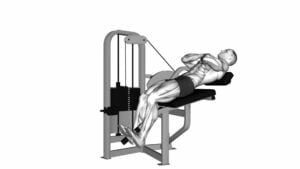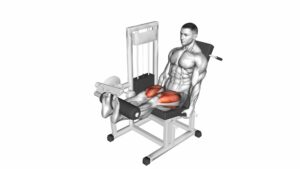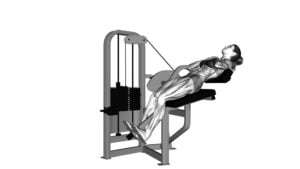Lever Back Extension – Video Exercise Guide & Tips

Looking to strengthen your back muscles? Check out this video exercise guide on lever back extensions.
Watch This Exercise Video
In just a few minutes a day, you can improve your posture, increase your flexibility, and reduce the risk of back pain. With proper form and technique, you'll engage the right muscles and maximize your results.
Whether you're a beginner or advanced, this workout is suitable for all fitness levels. So grab a mat and get ready to feel the burn!
Key Takeaways
- Lever back extension strengthens and tones back muscles.
- Lever back extension improves posture and enhances core strength.
- Lever back extension targets lower back muscles and alleviates back pain.
- Proper form and technique, as well as equipment setup, are crucial for a safe and effective lever back extension workout.
Benefits of Lever Back Extension
To fully understand the benefits of the Lever Back Extension, it's important that you incorporate this exercise into your regular fitness routine. Back extension exercises, like the Lever Back Extension, provide numerous benefits for your back and overall fitness.
One of the key benefits of the Lever Back Extension is its ability to strengthen and tone your back muscles. This exercise specifically targets the muscles in your lower back, helping to improve their strength and stability. By regularly performing this exercise, you can reduce the risk of back injuries and improve your posture.
Additionally, the Lever Back Extension helps to improve your overall core strength. This exercise engages your abdominal muscles, as well as your glutes and hamstrings, providing a full-body workout. Strengthening your core can help to improve your balance and stability, making everyday activities easier and reducing the risk of falls or other injuries.
Furthermore, the Lever Back Extension can also help to alleviate back pain. By strengthening the muscles in your back, you can reduce the strain on your spine, relieving pain and discomfort. Regularly incorporating this exercise into your fitness routine can help to prevent and manage chronic back pain.
Proper Form and Technique
Maintain proper form and technique during the Lever Back Extension exercise to maximize its effectiveness and minimize the risk of injury. Here are some key tips to help you perform this exercise correctly:
- Engage your core: Before starting the movement, activate your abdominal muscles by pulling your belly button towards your spine. This will provide stability and protect your lower back.
- Keep your spine neutral: Avoid arching or rounding your back during the exercise. Maintain a straight line from your head to your tailbone to ensure proper spinal alignment.
- Control the motion: Slowly lower your upper body towards the ground and then lift it back up using your back muscles. Avoid using momentum or relying on other muscle groups to perform the movement.
- Focus on muscle activation: Concentrate on squeezing your glutes and lower back muscles as you lift your upper body. This will enhance muscle activation and help you get the most out of the exercise.
Equipment and Setup
Now let's talk about the equipment and setup for the Lever Back Extension exercise. This exercise requires a lever back extension machine, which can usually be found in most gyms. To set up the machine, start by adjusting the footplate so that it aligns with your hips. Make sure your feet are securely placed on the footplate and that your knees are slightly bent.
Next, adjust the pad so that it rests comfortably against your lower back. This will provide support and stabilize your body during the exercise.
It's important to note that proper setup is crucial to prevent injury and ensure proper form. One common mistake isn't adjusting the footplate and pad properly, which can lead to strain on the lower back. Another mistake is placing the feet too high or low on the footplate, which can affect the range of motion and target the wrong muscles.
Now that you know how to set up the equipment for the Lever Back Extension exercise, let's move on to discussing variations and progressions to make your workout more challenging and effective.
Variations and Progressions
Try different variations and progressions of the Lever Back Extension exercise to challenge yourself and achieve greater effectiveness in your workout. By incorporating these variations, you can target different muscle groups and keep your workouts interesting. Here are four variations and progressions to try:
- Single-Leg Lever Back Extension: Lift one leg off the ground while performing the exercise. This variation increases the challenge on your glutes and hamstrings, helping to improve balance and stability.
- Weighted Lever Back Extension: Hold a dumbbell or kettlebell against your chest while performing the exercise. Adding weight increases the resistance, making your muscles work harder and promoting strength gains.
- Swiss Ball Lever Back Extension: Place a Swiss ball under your hips instead of using a lever machine. This variation engages your core muscles even more, as you have to stabilize yourself on the unstable surface of the ball.
- Reverse Lever Back Extension: Instead of extending your back, focus on lowering your upper body towards the ground. This variation targets your upper back muscles and can help improve posture.
By incorporating these variations and progressions into your Lever Back Extension exercise routine, you can challenge your body in new ways and continue to make progress.
Now, let's move on to some tips for a safe and effective workout.
Tips for a Safe and Effective Workout
To ensure a safe and effective workout, always warm up your muscles before starting the Lever Back Extension exercise. Warming up is crucial as it increases blood flow to your muscles, prepares your body for physical activity, and reduces the risk of injury.
Start with some light cardio exercises like jogging or jumping jacks to get your heart rate up and loosen your muscles. After that, perform dynamic stretches that target the muscles you'll be using during the Lever Back Extension. This will further warm up and mobilize your muscles, making them more flexible and ready for the exercise.
Now, let's discuss some common mistakes to avoid during the Lever Back Extension. First, don't rush through the exercise. Take your time and focus on maintaining proper form throughout the movement.
Secondly, avoid using excessive weight or resistance, especially if you're new to this exercise. Start with lighter weights and gradually increase the intensity as you become more comfortable and stronger.
Frequently Asked Questions
How Many Sets and Reps Should I Do for the Lever Back Extension Exercise?
For the lever back extension exercise, the optimal rep range is typically around 10-15 reps per set. This will help you target and strengthen your lower back muscles effectively.
Incorporating lever back extensions into your workout routine has several benefits. It helps improve posture, increases lower back strength, and enhances overall core stability.
Additionally, it can also alleviate lower back pain and prevent future injuries.
Can I Perform the Lever Back Extension Exercise if I Have Lower Back Pain?
If you have lower back pain, it's best to avoid the lever back extension exercise. Instead, try alternative exercises for lower back pain relief, such as bird dogs or cat-camel stretches.
It's important to listen to your body and not push through any pain. Make sure to warm up properly before exercising and incorporate core strengthening and flexibility exercises into your routine.
Remember to consult with a healthcare professional for personalized advice and tips for managing lower back pain during exercise.
Is the Lever Back Extension Exercise Suitable for Beginners?
Yes, the lever back extension exercise can be suitable for beginners. It's a great way to strengthen your lower back. However, it's important to perform it correctly to avoid common mistakes.
If you're a beginner, there are alternative exercises you can try to strengthen your lower back, such as the bird dog exercise or the cat-camel stretch. These exercises are less intense and can help you build a strong foundation before attempting the lever back extension.
Should I Use Additional Weights While Performing the Lever Back Extension Exercise?
When performing the lever back extension exercise, it's important to focus on maintaining proper form. Adding additional weights can increase the intensity of the exercise, but it isn't necessary for beginners. Start by mastering the proper technique and gradually increase the difficulty.
The lever back extension exercise offers numerous benefits, such as strengthening your lower back muscles, improving posture, and increasing overall core stability. Incorporating it into your workout routine can help you achieve a stronger and healthier body.
How Often Should I Include the Lever Back Extension Exercise in My Workout Routine?
To get the most out of your workout routine, it's important to include the lever back extension exercise regularly.
This exercise helps strengthen your lower back, glutes, and hamstrings while improving your posture.
To properly execute the lever back extension, lie face down on the lever, hook your feet under the pads, and lift your upper body off the ground.
Aim for 2-3 sets of 10-12 reps, 2-3 times a week for optimal results.
Conclusion
In conclusion, the lever back extension is a beneficial exercise for strengthening the lower back muscles. By maintaining proper form and technique, using the appropriate equipment and setup, and incorporating variations and progressions, you can maximize the effectiveness of this exercise.
Remember to follow the provided tips for a safe and effective workout. Incorporating lever back extensions into your fitness routine can help improve your overall strength and stability.

Author
Years ago, the spark of my life’s passion ignited in my mind the moment I stepped into the local gym for the first time. The inaugural bead of perspiration, the initial endeavor, the very first surge of endorphins, and a sense of pride that washed over me post-workout marked the beginning of my deep-seated interest in strength sports, fitness, and sports nutrition. This very curiosity blossomed rapidly into a profound fascination, propelling me to earn a Master’s degree in Physical Education from the Academy of Physical Education in Krakow, followed by a Sports Manager diploma from the Jagiellonian University. My journey of growth led me to gain more specialized qualifications, such as being a certified personal trainer with a focus on sports dietetics, a lifeguard, and an instructor for wellness and corrective gymnastics. Theoretical knowledge paired seamlessly with practical experience, reinforcing my belief that the transformation of individuals under my guidance was also a reflection of my personal growth. This belief holds true even today. Each day, I strive to push the boundaries and explore new realms. These realms gently elevate me to greater heights. The unique combination of passion for my field and the continuous quest for growth fuels my drive to break new ground.



